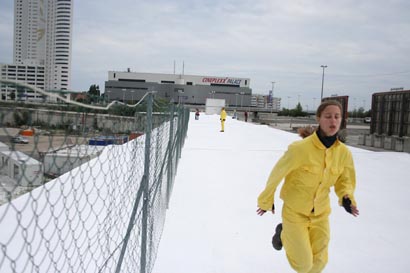| 02.09. - 30.09.2005 palais donaustadt – installation. temporary art space at donaucity vienna with the formats ballet palais, firma raumforschung, archiv im palais, film im palais, picknick am wegesrand (a) |
press review
concept / installation
ballet palais
firma raumforschung
film im palais
archiv im palais
picknick am wegesrand
publication: skizzen des verschwindens |
|
the projects of theatercombinat create and investigate new experimental areas of action and perception - border zones between fine art, theater and dance, theory and architecture: from june to august 2005, a theatrical choreography was developed on the grounds of a yet unimproved site at donaucity vienna and presented during september 2005. a spatial ready-made as extended theatre space, marked by an installation turning into a stage.
ballet palais is the second part of a series of theatrical research about the perception of images and space which started in 2005 at the former and in 2009 reopened jewish theater «nestroyhof» with ou est donc le tableau. |
ballet palais - a phantasie of space and time colliding with functionalised social surroundings.
by + with markus keim, julia reinartz, angela schubot, matthew smith, christine standfest and doris uhlich, choreography/direction: claudia bosse
premiere: 2.9.2005, 13 showings
|
|
 |
zweifel am bild
zweifel am sehen
zweifel am betrachter
fragmentary reconstruction
die handlung ist beliebig
da die folgen vergangenheit sind
nämlich der beobachter stehe unter beobachtung
(heiner müller)
(doubting the picture
doubting seeing
doubting the spectator
fragmentary reconstruction
the action is arbitrary
because the consequences are past
namely the observer is
under observation)
|
|
how can this space evoke concentration? how can you deal with the gaze and its regimes between performers and observers, between accidental passers-by and the workforce of the surrounding offices? how will the conditions of weather and light affect the theatrical work? how can we react to influences, noise, irritations from the environment? how do installative interventions operate, and how can we deal with the infinity of the given installation space?
the wide horizon above the danube contrasts with the vertical layers of the office towers. other than the small theatre space of nestroysäle, this space seems unlimited, indefinite and undefined. the gazes are cursory. the surrounding architectural and social context is part of the space and the investigation.
bodies sweep above the area beyond gestures of representation. they confront their movements with the location, creating frictions between art and daily life. within this framing, six dancers/performers actualise movement-vocabulary developed beforehand in different combinations and variations, following obvious and - by the spectator - mentally reconstructable rules as well as unforeseeable variations and new orders. within these experimental arrangements, displacements, transcriptions and rewritings are produced: decentered space-ensembles, which position the spectators in space - as physical presences they are part of the moving frame as well as at the same time being distanced spectators informed by general, culturally adopted and individualised cognitive participation and anticipation.
(questions by c.b., june 2005) |

|
|
 |
white space, white time
claudia bosse |
|
dramaturgies of attention. the space stands still through the movements of the dancers. it is slowed down, at times accelerated, therefore becoming observable. the space is silenced, concentrated, therefore hearable. the wideness of the space is argued by six bodies. it is captured by walking, dwelling. composed time. different times emerge by rhythmical execution of simple acts like walking and standing, by the testimony of the spectators with their bodily presence, by indulging in a different mode of reception.
the luxury of silence, rendered noisy by passing cars. no spoken words. the luxury of time. leaps in space, leaps in time. leaps in perception. repetitions resound in space, of things just happening, changing. a resonance space for a story just written and already deleted. traces remain of bodies, traces of space. everything else changes. the chorical organisation of the bodies highlights them against the promises of the individualised surroundings, but there are none. an organisation of bodies, reacting together. the space is shared with spectators, passers-by.
they watch the gestures of the spectators in watching, relate or counter-read them with the traces and gestures of bodies. the spectators compare the movements of the passers-by with those of the dancers and the movements of the moving spectators. a collective production in space and time.
space and physical activities are at the same time luxury and challenge for self-conceptions and desires in reception.
a residual in white, some thing not yet or different, white space, white time, shared.
|
www.theatercombinat.com theatrale produktion und rezeption |